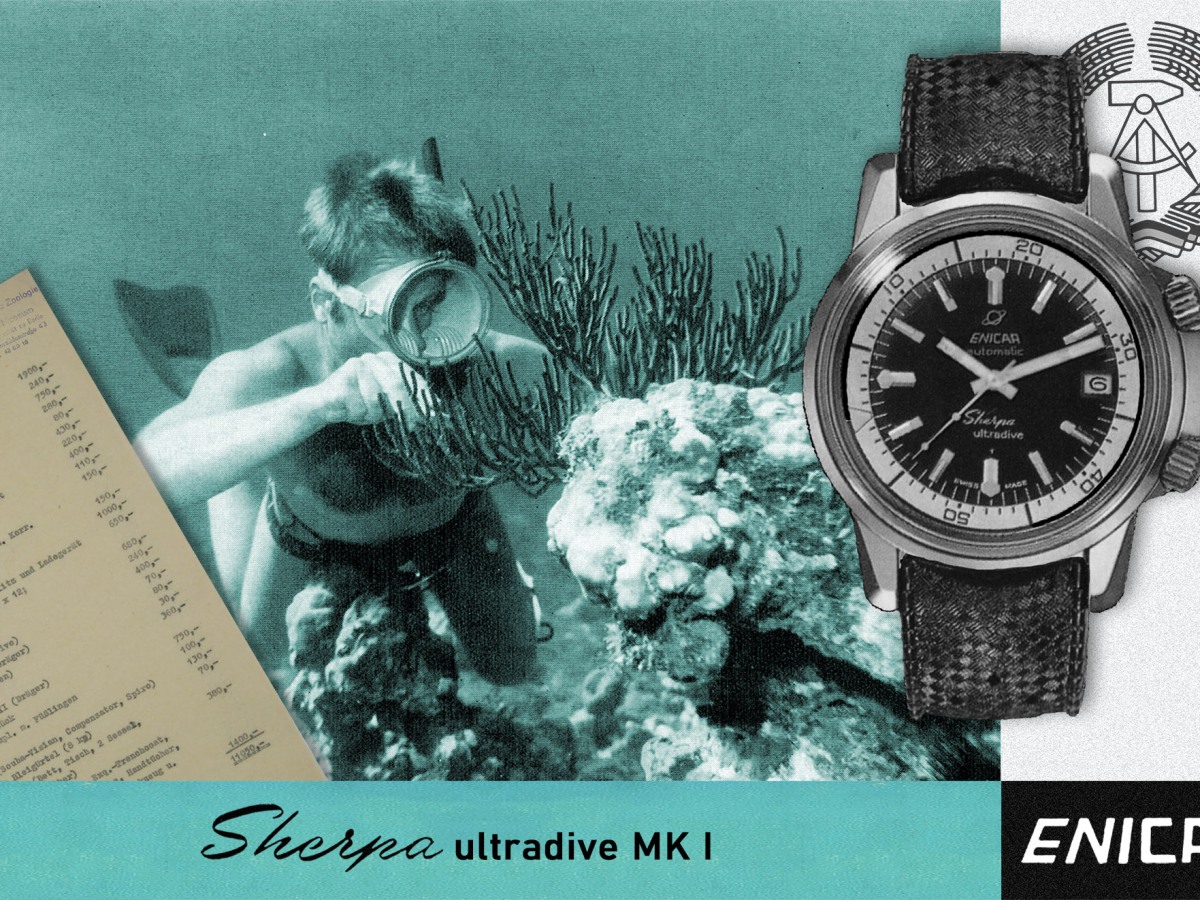Just recently I got all issues of the German diving magazin “Neptun”. First issued in 1960 and discontinued in 1967 it is a nice archive of diving history. In the following example of January 1961 you will find the review of an Enicar Sherpa Dive which I’d like to share with you.
In short: The Sherpa Dive suits all underwater challenges and won’t destroy your shirt 😉


Neptune Test
Enicar “Sherpa-Dive 600 Supertest”. Diver’s wristwatch with self-winding, rotating bezel and positioning mark for setting calculated ascent and decompression times. The movement and case of this model are subjected to particularly demanding laboratory tests during manufacture. Manufacturer: Enicar S. A., Lengnau near Biel (Switzerland). Price: sFr. 197.- / DM 235.-
Shape: round. Diameter 4 cm (smaller model “Sherpa-Divette” with a diameter of 3.5 cm). Case height including glass 11 mm.
Dial: black, without numbers, with clearly visible white hour markers, of which the fields for 3, 6, 9 and 12 o’clock are wide, the others are somewhat narrower. The corresponding light green luminous marks also emerge clearly and distinctly in the darkness, shaped and dimensioned in such a way that their reinterpretation in the correct number of hours appears secured. Minute division with fine white lines.
Hands: Wide, luminous hands that are perfectly visible even in the dark. Second hand from the center, with a strong luminous point at the tip.
Strap: plastic strap with buckle. Can be easily extended with the included buckle strap so that the watch can be worn over a diving suit. The anti-skid profile on the inside of the strap, also useful when the watch is worn over a diving suit, should be a bit finer and wider for use when diving without protection against the cold.
Bezel: Black, with white dots as a minute division, white lines as five-minute marks, or numbers for 10, 20, 40 and 50 minutes. The edge is handy, but not too pronounced, so the shirt cuffs should remain intact, which is not is the case with all diving watches on the market. Inserted between the glass and the black bezel is a narrow ring that carries a red marker, which is used to define a planned dive, but is also ideally suited to demarcate diving stops. The black bezel, which has a red counter-mark or one marked with luminous dots, then does not need to be adjusted, and the total diving time can be read at any time. The red ring was a little too easy to turn on the test piece. The accidental adjusting of the set markers must be avoid.

Crown: Not recessed, but not rising above the level of the edge ring, so that there is hardly any risk of getting stuck. The manufacturer also assures that the case is guaranteed to remain watertight even when the crown is pulled out.
Accuracy: In a chronometer comparison, no time difference was found in the test piece within 48 hours.
Water-Proofness: Flawless in practical diving, even when the thermocline temperature changes and with the crown pulled out. Combined temperature and pressure tests in the laboratory confirmed the immersion test results. The following table provides information about the corresponding tests:
| Water Temp. | Pressure | Immersion Time | Crown Position | Water-Proofness |
| 20 °C | 13 atm | 15 min | in | positive |
| 20 °C | 13 atm | 15 min | pulled | positive |
| 4 °C | 13 atm | 15 min | in | positive |
| 8 °C | 13 atm | 15 min | pulled | positive |
| 30 °C | 13 atm | 15 min | in | positive |
| 30 °C | 13 atm | 15 min | pulled | negative |
Only in the last test – under conditions that do not exist at all in normal diving practice – there was fog on the crystal, which not disappeared. On the other hand, the watch remained tight after heating to 50 ° C during the sudden transition into water of 10 ° C as well as with a load of 30 kg / cm² (= 300m water depth).
Final verdict: The “Sherpa-Dive 600 Supertest” is a somewhat conspicuous, but extremely robust and reliable watch, equally suitable for sport and professional divers, consistently equipped according to the necessities of underwater use. It should withstand any stress that can be expected in practice and thus definitely meet the quality requirements that must be placed on diving equipment.
-Neptune tester



